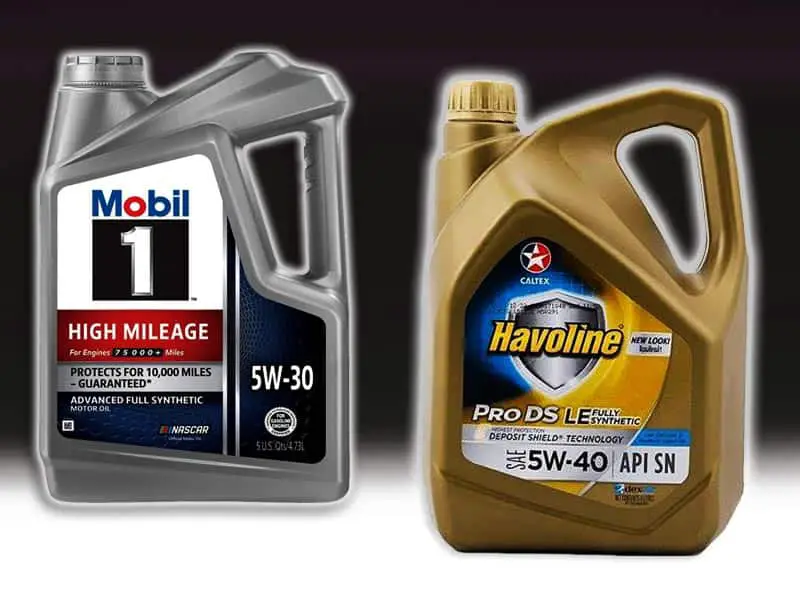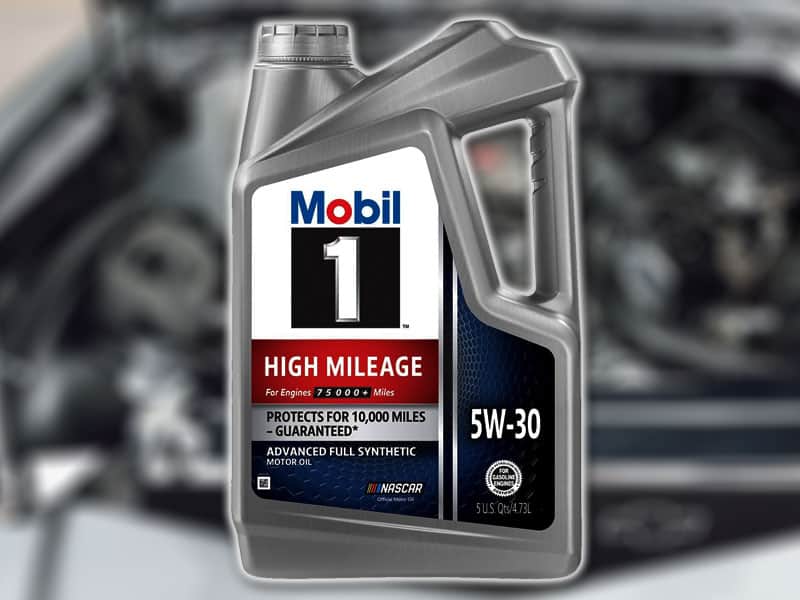Both oils are entirely synthetic mainly developed to be used in gasoline engines only. Havoline Pro-DS High Mileage focuses more on engine rinsing, on the other hand, Mobil 1 High Mileage’s center of focus is fuel economy.
Pro-DS contains greater quantities of detergents and dispersants to ensure a dominating performance in cleaning the engine from sludge and other impurities.

The anti-wearing additives are present in higher concentrations to protect the engine from degradation. The greater viscosity index of the oil ensures maintaining its viscosity during the variations in temperature from medium to high.
High Mileage provides efficient working of the catalytic converter due to its lower ZDDP compounds concentrations. It contains medium quantities of detergents and dispersants to allow compatible engine cleaning.

This oil possesses fewer lightweight molecules to protect its early and quick burning. At higher temperatures, the performance of High Mileage is superior as it has a high viscosity index. The higher base additives ensure longer durations of changing the oil.
Table of Contents
Comparing Oil Viscosity
The restriction in the movement of fluid is generally described as Kinematic viscosity. An oil possessing greater kinematic viscosity ensures dominating working of the motor oil at elevated temperatures.
The capability of the motor oil to maintain its kinematic viscosity during temperature variations is known as the viscosity index. A higher viscosity index causes lower changes in oil viscosity.
The lower temperature beneath which the oil stops flowing is termed as pour point temperature. And the oil working in colder regions is characterized by this pour point temperature.
The performance of both these oils at 40 o C is almost similar. However, the working of High Mileage is marginally better at 100 o C due to its higher kinematic viscosity at the mentioned temperature. When it comes to retaining kinematic viscosity, Pro-DS is ahead of its counterpart because of its greater viscosity index.
For performances in chilly and cold conditions, these two oils are equally compatible because of their identical pour point temperatures.
| Oils in Contrast (5W-30 Grade oil) | Kinematic Viscosity during medium temperature (40 o C) (mm2/s) | Kinematic Viscosity during higher temperature (100 o C) (mm2/s) | Viscosity index (VI) | Pour point (o C) |
| Havoline Pro-DS | 61 | 10.8 | 171 | -45 |
| Mobil 1 High Mileage | 60.9 | 11.2 | 168 | -45 |
Comparing Duration of Oil Replacement
Different bases are included in the oil to counterbalance the acid formations during the combustion process. These acids are extremely dangerous as it causes corrosion decreasing the engine’s life.
TBN (Total Base Additives) is used to measure their concentrations in the oil. The concentrations of these bases reduce over time due to continuous interactions with the acids.
Therefore, higher TBN will ensure a higher duration of exchanging the oil.
Pro-DS has a lower TBN indicating that it has relatively lower amounts of base additives. Therefore, it has a higher frequency of replacing the oil.
The recommended distance after which the oil needs to be replaced is between 3,000 to 7,500 miles.
Conversely, High Mileage as the name suggests provides higher mileage compared to its peer because of its greater TBN. It is required to be changed after covering a distance of around 10,000 miles.
Price Dissimilarity
Pro-DS has a higher cost compared to the other oil. A 5 Quarts container of oil is available at a price tag of around 35.08 US Dollars.
The superior cleaning of the engine and better safeguard against engine wearing however compensate this higher price of the oil.
Meanwhile, High Mileage is available at a much cheaper cost. A similar 5 Quart container of the oil costs around 27.47 US Dollars, making this oil more budget-friendly than its counterpart.
Table of Contrast
| Details | Havoline Pro DS High Mileage (5W-30) | Mobil 1 High Mileage (5W-30) |
| Oil Classification | Totally Synthetic | Totally Synthetic |
| Engine Classification | Gasoline | Gasoline |
| Viscosity grades Accessibility | 5W-30, 5W-20, 0W-20 | 5W-30, 5W-20, 10W-40, 10W-30, 0W-20 |
| ILSAC | GF-6 | GF-6 |
| API | SP, SN Plus | SN, SN PLUS |
| Price (5 Quarts.) | 35.08 $ | 27.47 $ |
| Frequency of oil exchanging (miles) | 3,000 to 7,500 | 10,000 |
| Supplements | Dispersants, Anti-wear, Detergents | Anti-foam agents, Detergents, Anti-wears, Dispersants |
| ACEA | Unavailable | A5/B5 |
Contrasting Catalytic Converter Working
The reaction of an oxidized oil with ZDDP compounds (zinc and phosphorus) forms a toxic ash residue. This poisonous ash enters into the catalytic converter making it jam. In this way, the formation of ash proves to have an adverse effect on the converter performance.
The higher the concentrations of zinc and phosphorus compounds greater will be the hindrance in converter performance and vice versa.
Pro-DS contains relatively higher quantities of these anti-wearing compounds thereby producing more ash than that of its rival. Therefore, it is less effective with reference to catalytic converter performance.
On the other hand, High Mileage possesses these ZDDP compounds in slightly lesser amounts enabling this oil to provide superior catalytic converter performances.
Contrasting Sludge Formation
When oxidized oil comes in contact with some contaminations like dust or moisture, it leads to the build-up of thick black fluid known as sludge.
The sludge act as a hurdle in engine proper working by blocking the path of oil flowing in the pipes. Detergents are being added along with dispersants to lower this cause.
More concentrations of detergent additives will provide higher protection against sludge formation.
The concentrations of detergents are higher in Pro-DS enabling it to give a smoother flow of oil inside the engine because of its lower sludge formation.
On the contrary, the amounts of these sludge reducing agents are comparatively on the lower side in High Mileage therefore it provides lower protection against sludge production thus making it second to that of its peer.
Contrasting Oil Early Ignition
The ignition of oil at a lower temperature is dependent on the existence of lighter molecules. Their existence in higher amounts increases the rate of evaporation which further enhances the oil volatility. This is because these molecules will not be able to withstand high temperatures and will evaporate rapidly due to their early breakdown.
Pro-DS contains lightweight molecules in higher amounts. This makes this oil to be relatively more volatile as it reaches its flashpoint before the required temperature. Meanwhile, High Mileage possesses higher flashpoint temperature as it contains these lighter molecules in fewer numbers. As a result, it provides better protection against the oil’s early burn-off.
| Oils in Contrast (5W-30 Grade oil) | Flash Point (o C) |
| Havoline Pro-DS | 226 |
| Mobil 1 High Mileage | 245 |
Comparing Shielding Against Engine Wear
The continuous skidding of moving parts of engine over each other produces friction which in turn leads to its wear and tear. To minimize this cause, the addition of anti-wearing compounds is done.
The purpose of these compounds is to build a fine film around these parts, restricting them to interact with one another. The oil containing anti-wear agents in greater quantities will provide better lubrication and more shielding from engine degradation.
The concentrations of anti-wearing compounds are higher in Pro-DS enabling it to provide superior protection against these wear and tear. Whereas High Mileage possesses anti-wear compounds in comparatively lower amounts thereby forming weak layers around the moving parts of the engine.
For this reason, High Mileage is behind its competitor in terms of wearing protection.
Summary
- Both oils are entirely synthetic and can be used for gasoline types of engines only.
- High Mileage provides more efficient performances of catalytic converter due to its lower zinc and phosphorus concentrations.
- In terms of engine cleaning, Pro-DS is ahead as it contains more concentrations of detergents and dispersants.
- High Mileage provides more protection against early oil burn-off due to its fewer lighter molecules.
- Pro-DS provides higher protection against engine wear and tear.
- Pro-DS experiences lower variations in its kinematic viscosity when the temperature shifts from 40 to 100 o C.
- High Mileage has lower oil changing frequency because of its higher TBN.
- The price of High Mileage is lower making it more economical and affordable.